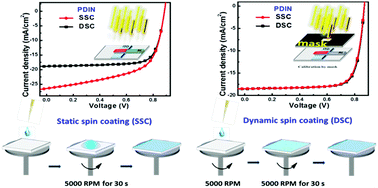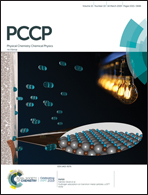One key issue in characterization of organic solar cells with solution processed interfacial layers†
Abstract
Solution processed interfacial layers are commonly employed in bulk heterojunction organic solar cells (OSCs) for better charge collection. PDIN interfacial layers were prepared by employing a static or dynamic spin coating method from PDIN methanol solution, and defined as the S-PDIN or D-PDIN layer. The OSCs with a S-PDIN layer exhibit 13.88% power conversion efficiency (PCE) with a virtual high short circuit density (JSC) of 26.45 mA cm−2 and relatively low fill factor (FF) of 58.94% during the current density versus voltage (J–V) measurement without a shadow mask. 12.56% PCE is achieved for OSCs with a D-PDIN layer, along with a JSC of 18.85 mA cm−2 and FF of 74.88%. Over 77% FFs are obtained for OSCs with a S-PDIN or D-PDIN layer during J–V measurement with a shadow mask, and both OSCs exhibit a very similar JSC and PCE. The virtual high JSCs and relatively low FF of OSCs with a S-PDIN layer may be due to the enhanced conductivity of PEDOT:PSS during preparation of the PDIN layer by the SSC method, which can be further confirmed from the OSCs with a methanol treated PEDOT:PSS layer. This work indicates that a well-balanced JSC and FF should be an important evaluating indicator for efficient OSCs, and an appropriate shadow mask is necessary to measure the J–V curves of OSCs with a solution processed interfacial layer.



 Please wait while we load your content...
Please wait while we load your content...